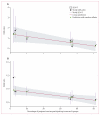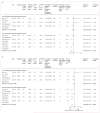Women's groups practising participatory learning and action to improve maternal and newborn health in low-resource settings: a systematic review and meta-analysis - PubMed (original) (raw)
Review
. 2013 May 18;381(9879):1736-46.
doi: 10.1016/S0140-6736(13)60685-6.
Tim Colbourn, Nadine Seward, Kishwar Azad, Arri Coomarasamy, Andrew Copas, Tanja A J Houweling, Edward Fottrell, Abdul Kuddus, Sonia Lewycka, Christine MacArthur, Dharma Manandhar, Joanna Morrison, Charles Mwansambo, Nirmala Nair, Bejoy Nambiar, David Osrin, Christina Pagel, Tambosi Phiri, Anni-Maria Pulkki-Brännström, Mikey Rosato, Jolene Skordis-Worrall, Naomi Saville, Neena Shah More, Bhim Shrestha, Prasanta Tripathy, Amie Wilson, Anthony Costello
Affiliations
- PMID: 23683640
- PMCID: PMC3797417
- DOI: 10.1016/S0140-6736(13)60685-6
Review
Women's groups practising participatory learning and action to improve maternal and newborn health in low-resource settings: a systematic review and meta-analysis
Audrey Prost et al. Lancet. 2013.
Erratum in
- Lancet. 2014 May 24;383(9931):1806
Abstract
Background: Maternal and neonatal mortality rates remain high in many low-income and middle-income countries. Different approaches for the improvement of birth outcomes have been used in community-based interventions, with heterogeneous effects on survival. We assessed the effects of women's groups practising participatory learning and action, compared with usual care, on birth outcomes in low-resource settings.
Methods: We did a systematic review and meta-analysis of randomised controlled trials undertaken in Bangladesh, India, Malawi, and Nepal in which the effects of women's groups practising participatory learning and action were assessed to identify population-level predictors of effect on maternal mortality, neonatal mortality, and stillbirths. We also reviewed the cost-effectiveness of the women's group intervention and estimated its potential effect at scale in Countdown countries.
Findings: Seven trials (119,428 births) met the inclusion criteria. Meta-analyses of all trials showed that exposure to women's groups was associated with a 37% reduction in maternal mortality (odds ratio 0.63, 95% CI 0.32-0.94), a 23% reduction in neonatal mortality (0.77, 0.65-0.90), and a 9% non-significant reduction in stillbirths (0.91, 0.79-1.03), with high heterogeneity for maternal (I(2)=58.8%, p=0.024) and neonatal results (I(2)=64.7%, p=0.009). In the meta-regression analyses, the proportion of pregnant women in groups was linearly associated with reduction in both maternal and neonatal mortality (p=0.026 and p=0.011, respectively). A subgroup analysis of the four studies in which at least 30% of pregnant women participated in groups showed a 55% reduction in maternal mortality (0.45, 0.17-0.73) and a 33% reduction in neonatal mortality (0.67, 0.59-0.74). The intervention was cost effective by WHO standards and could save an estimated 283,000 newborn infants and 41,100 mothers per year if implemented in rural areas of 74 Countdown countries.
Interpretation: With the participation of at least a third of pregnant women and adequate population coverage, women's groups practising participatory learning and action are a cost-effective strategy to improve maternal and neonatal survival in low-resource settings.
Funding: Wellcome Trust, Ammalife, and National Institute for Health Research Collaboration for Leadership in Applied Health Research and Care for Birmingham and the Black Country programme.
Copyright © 2013 Elsevier Ltd. All rights reserved.
Figures
Figure 1. Flow chart of the study selection process
Figure 2. Meta-analysis of the effect of women’s groups practising participatory learning and action on maternal mortality (A) and neonatal mortality (B)
Weights are from random-effects analysis.
Figure 3. Meta-regression analysis of the effect of women’s groups by percentage of pregnant women participating in groups for (A) maternal mortality and (B) neonatal mortality
Green triangles show the predicted effect with random-effects meta-regression to allow for between study variation.
Figure 4. Subgroup analysis of the effect of women’s groups on maternal mortality (A) and neonatal mortality (B), by percentage of pregnant women participating in groups
Weights are from random-effects analysis.
Comment in
- Participatory women's groups: ready for prime time?
Victora CG, Barros FC. Victora CG, et al. Lancet. 2013 May 18;381(9879):1693-4. doi: 10.1016/S0140-6736(13)61029-6. Lancet. 2013. PMID: 23683618 No abstract available. - Can women's groups reduce maternal and newborn deaths?
Kirkwood B, Bahl R. Kirkwood B, et al. Lancet. 2013 May 18;381(9879):e12-4. doi: 10.1016/S0140-6736(13)60985-X. Lancet. 2013. PMID: 23683647 No abstract available. - Analyses confirm effect of women's groups on maternal and newborn deaths.
Prost A, Colbourn T, Tripathy P, Osrin D, Costello A. Prost A, et al. Lancet. 2013 May 18;381(9879):e15. doi: 10.1016/S0140-6736(13)61082-X. Lancet. 2013. PMID: 23683648 No abstract available. - Trials of participation to improve maternal and newborn health.
Rifkin S. Rifkin S. Lancet. 2013 Aug 24;382(9893):681. doi: 10.1016/S0140-6736(13)61771-7. Lancet. 2013. PMID: 23972806 No abstract available. - Trials of participation to improve maternal and newborn health - Authors' reply.
Prost A, Rosato M, Tripathy P, Costello A. Prost A, et al. Lancet. 2013 Aug 24;382(9893):681-2. doi: 10.1016/S0140-6736(13)61772-9. Lancet. 2013. PMID: 23972807 No abstract available.
Similar articles
- Effects of women's groups practising participatory learning and action on preventive and care-seeking behaviours to reduce neonatal mortality: A meta-analysis of cluster-randomised trials.
Seward N, Neuman M, Colbourn T, Osrin D, Lewycka S, Azad K, Costello A, Das S, Fottrell E, Kuddus A, Manandhar D, Nair N, Nambiar B, Shah More N, Phiri T, Tripathy P, Prost A. Seward N, et al. PLoS Med. 2017 Dec 5;14(12):e1002467. doi: 10.1371/journal.pmed.1002467. eCollection 2017 Dec. PLoS Med. 2017. PMID: 29206833 Free PMC article. - Effect of participatory women's groups facilitated by Accredited Social Health Activists on birth outcomes in rural eastern India: a cluster-randomised controlled trial.
Tripathy P, Nair N, Sinha R, Rath S, Gope RK, Rath S, Roy SS, Bajpai A, Singh V, Nath V, Ali S, Kundu AK, Choudhury D, Ghosh SK, Kumar S, Mahapatra R, Costello A, Fottrell E, Houweling TA, Prost A. Tripathy P, et al. Lancet Glob Health. 2016 Feb;4(2):e119-28. doi: 10.1016/S2214-109X(15)00287-9. Lancet Glob Health. 2016. PMID: 26823213 Clinical Trial. - The equity impact of community women's groups to reduce neonatal mortality: a meta-analysis of four cluster randomized trials.
Houweling TAJ, Looman CWN, Azad K, Das S, King C, Kuddus A, Lewycka S, Manandhar DS, Sah More N, Morrison J, Phiri T, Rath S, Rosato M, Sen A, Tripathy P, Prost A, Osrin D, Costello A. Houweling TAJ, et al. Int J Epidemiol. 2019 Feb 1;48(1):168-182. doi: 10.1093/ije/dyx160. Int J Epidemiol. 2019. PMID: 29024995 Free PMC article. - Could Postnatal Women's Groups Be Used to Improve Outcomes for Mothers and Children in High-Income Countries? A Systematic Review.
Sikorski C, Van Hees S, Lakhanpaul M, Benton L, Martin J, Costello A, Heys M. Sikorski C, et al. Matern Child Health J. 2018 Dec;22(12):1698-1712. doi: 10.1007/s10995-018-2606-y. Matern Child Health J. 2018. PMID: 30155582 Free PMC article. Review. - Birth Preparedness and Complication Readiness (BPCR) interventions to reduce maternal and neonatal mortality in developing countries: systematic review and meta-analysis.
Soubeiga D, Gauvin L, Hatem MA, Johri M. Soubeiga D, et al. BMC Pregnancy Childbirth. 2014 Apr 4;14:129. doi: 10.1186/1471-2393-14-129. BMC Pregnancy Childbirth. 2014. PMID: 24708719 Free PMC article. Review.
Cited by
- Participants in a peer-based nutrition and health program in Zimbabwe value dialogue, peer support, and tangible action: A qualitative exploration of peer group experiences.
Auer SR, Matandirotya N, Mathe P, Moyo M, Sherburne L, Dickin KL. Auer SR, et al. PLOS Glob Public Health. 2024 Oct 2;4(10):e0003525. doi: 10.1371/journal.pgph.0003525. eCollection 2024. PLOS Glob Public Health. 2024. PMID: 39356690 Free PMC article. - Patient and public involvement in healthcare: a systematic mapping review of systematic reviews - identification of current research and possible directions for future research.
Bergholtz J, Wolf A, Crine V, Cleeve H, Santana MJ, Björkman I. Bergholtz J, et al. BMJ Open. 2024 Sep 19;14(9):e083215. doi: 10.1136/bmjopen-2023-083215. BMJ Open. 2024. PMID: 39304210 Free PMC article. - Where have I got to? Associations of age at marriage with marital household assets in educated and uneducated women in lowland Nepal.
Marphatia AA, Saville NM, Manandhar DS, Cortina-Borja M, Wells JCK. Marphatia AA, et al. PeerJ. 2024 Aug 7;12:e17671. doi: 10.7717/peerj.17671. eCollection 2024. PeerJ. 2024. PMID: 39131621 Free PMC article. - Cost-effectiveness of group medical visits and microfinance interventions versus usual care to manage hypertension in Kenya: a secondary modelling analysis of data from the Bridging Income Generation with Group Integrated Care (BIGPIC) trial.
Chay J, Su RJ, Kamano JH, Andama B, Bloomfield GS, Delong AK, Horowitz CR, Menya D, Mugo R, Orango V, Pastakia SD, Wanyonyi C, Vedanthan R, Finkelstein EA. Chay J, et al. Lancet Glob Health. 2024 Aug;12(8):e1331-e1342. doi: 10.1016/S2214-109X(24)00188-8. Lancet Glob Health. 2024. PMID: 39030063 Free PMC article. Clinical Trial. - Learning from success: the main drivers of the maternal and newborn health transition in seven positive-outlier countries and implications for future policies and programmes.
Campbell OMR, Amouzou A, Blumenberg C, Boerma T; Countdown to 2030 Exemplars Collaboration. Campbell OMR, et al. BMJ Glob Health. 2024 May 6;9(Suppl 2):e012126. doi: 10.1136/bmjgh-2023-012126. BMJ Glob Health. 2024. PMID: 38770812 Free PMC article. Review.
References
- WHO. UNICEF [accessed Feb 8, 2013];Countdown 2015: building a future for women and children, the 2012 report. http://countdown2015mnch.org/documents/2012Report/2012-Complete.pdf.
- Lozano R, Wang H, Foreman KJ, et al. Progress towards Millennium Development Goals 4 and 5 on maternal and child mortality: an updated systematic analysis. Lancet. 2011;378:1139–65. - PubMed
- UNICEF . Levels and trends in child mortality: estimates developed by the UN Inter-agency Group for Child Mortality Estimation. UNICEF; New York: [accessed Feb 8, 2013]. 2012. http://www.childinfo.org/files/Child_Mortality_Report_2012.pdf.
- Darmstadt GL, Bhutta ZA, Cousens S, Adam T, Walker N, de Bernis L, for the Lancet Neonatal Survival Steering Team Evidence-based, cost-effective interventions: how many newborn babies can we save? Lancet. 2005;365:977–88. - PubMed
- Lassi ZS, Haider BA, Bhutta ZA. Community-based intervention packages for reducing maternal and neonatal morbidity and mortality and improving neonatal outcomes. Cochrane Database Syst Rev. 2010;11:CD007754. - PubMed
Publication types
MeSH terms
LinkOut - more resources
Full Text Sources
Other Literature Sources
Medical
Miscellaneous



